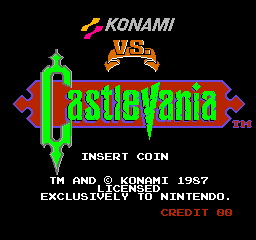
Arcade Mermaid is our classic arcade weirdness and obscurity column! Frequently (no promises) we aim to bring you an interesting and odd arcade game to wonder at.
You are reading the words of a Castlevania fanatic. Your standard fan who came into the series with the Igavanias will tell you its pinnacles are Symphony of the Night or, if they’re really trying to impress, Rondo of Blood. Truthfully, both of those are fine games. But I am of the opinion that the best the series has ever been was the first and third Famicom/NES games, and that series creator Hitoshi Akamatsu got a raw deal. The first game particularly is an especially brilliant gem among the jewels of the early Famicom’s library. Every moment of it shows care and attention to detail.
Just a few examples. While many people curse the stream of Medusa Heads that harry Simon Belmont at several places in the game, the game is actually quite sparing with their use, easing up with them at certain telling moments. One particular place this happens is climbing the staircases in the second stage of Block 3: while you’re on the staircases there, interestingly, the Medusa Heads don’t attack.
Also, the Fish Men in the first and fourth blocks, on the first loop, are kind enough never to jump from beneath the player’s location. And while on the second and later loops through the game they will happily emerge right beneath your feet and bump you into the water, there is a tell even for this: except for a brief section where there are no candles, Fish Men only emerge from the water directly beneath candle locations. (I gained a small amount of internet notoriety when an online friend pointed out where I had observed this fact in a Metafilter thread.)
I could go on, and will for a few more sentences, even though this kind of stuff makes for boring writing. The subweapons are very precisely designed, each filling a specific role in the game. All of the game’s platforms are supported by background elements, and when the player climbs stairs to a new area, background pillars in the upper area mostly line up with those from the lower area. You can see the crumbling spire that’s the site of the Dracula fight far in the background in block 3, half of the game before you get to climb up there yourself, and it’s such an iconic piece of level design that almost every Castlevania game that follows includes it. Much of its brilliance is recounted by Jeremy Parish in his book on the NES Castlevania games. (An earlier version of the Castlevania material can be seen linked here on the Internet Archive, but please consider his book if you are able to buy it.)
All of this is just preamble though, to the true subject of this post: the port for Nintendo’s Unisystem arcade hardware, Vs. Castlevania.

Castlevania is renowned as a tough game. While it only has six “blocks,” broken down into 19 stages, the game ramps up in difficulty pretty quickly through that thin territory. I’ve played through it all dozens of times. I’ve completed the game on one life before, but I still find the last level challenging. Even so, I’ve rolled both the score counter and stage counter. I’m good at Castlevania, not speedrunner-level, but, no offense intended to those who are, I have other things that I have to do. I cannot devote huge blocks of time to mastering individual games like I could as a teenager.
If you enjoy the original Castlevania, you might want to have a look at the Vs. variant, which is available via the Arcade Archives series for current consoles. Especially if you count yourself a master at it, this version will probably put you in your place.
In terms of hardware, the Unisystem is very close to a NES, and Vs. Castlevania doesn’t use any tricks that its home version doesn’t. Here is video of me playing through the first level:
People familiar with the original will notice that the game looks slightly different. The colors are different, which is something that was frequently the case of the arcade versions of NES software. It’s likely that the Unisystem’s hardware is responsible for this: as a protection against bootlegging, which was rife in the arcade industry, each Unisystem arcade board had, in addition to the ROMs with the code for each game, a specific, custom PPU chip with the palette for that game embedded within it. People who copied the ROM chips into EPROMs in order to run a game without buying it from Nintendo would have something that could technically run, but the palette would be for the original game, not the copied one, and make the colors look funny. While I don’t know if this is true for Vs. Castlevania, it might explain the difference if the whole game had to use a single palette set.
Two major differences between Vs. Castlevania and its home version are immediately evident. One, in the first level enemies do four bars of damage on each hit to protagonist Simon Belmont. The first couple of levels of NES Castlevania are mostly just a warmup. Enemies in both blocks only do two bars of damage, meaning even without health powerups Simon can take seven hits without dying. The increased damage is the same as on the game’s second loop, after finishing the whole thing and starting from the beginning. The arcade sensibility, to keep players putting in money in order to learn the game and see its later stages, means it doesn’t have time to let the player acclimate themselves to its heated waters. The fire is lit; the soup is boiling.
Even worse though is that, for each of the first three blocks of the game, the player only has 170 seconds to finish. It’s quite a shock if you’re used to the original, where time is practically never an issue! Even if you’ve mastered the levels on the NES, you’ll find, if you don’t constantly work towards reaching the door of each stage, you will easily run out of time. Expect the warning alarm to be ringing through the boss fights until you get used to the constant progress the game demands.
I don’t know what it is about the later blocks, but they have much more generous time limits, along the lines of the NES version. For these levels, the challenge goes back to surviving enemy attacks. Starting with Block 3, the game increases the damage done by enemies to levels never seen in the NES game even at its hardest: six bars, enough to kill Simon in just three hits. This makes Dracula at the end of the game quite a challenge.
If you manage to loop the game, you get to see something quite amazing. Desperate to end the player’s credit now, the game increases the damage done by enemies to eight bars, killing Simon Belmont in just two hits. More than that, the game pulls off the stops with nuisance enemies. You even have to face bats in the outside area before entering the castle! Take a look at this:
The extra nuisance enemies are an especially interesting addition, since NES Castlevania never uses so many, even on the second loop and beyond. It’s exactly the kind of ludicrous challenge that people who have mastered the original game should seek out!
Castlevania is not the only Vs. game with substantial differences from the arcade version. Vs. Excitebike has many niceties over the home version, including some clever bonus stages. Vs. Balloon Fight in the arcade is a vertically-scrolling game, that played with two players gives each its own monitor. There’s lots mot to say about these games, but I’ve got to save some material for later.
